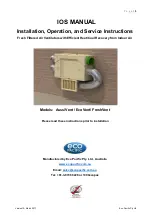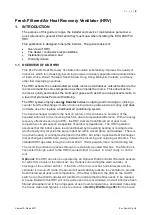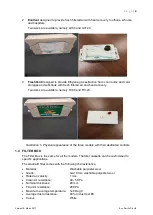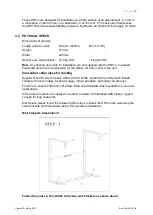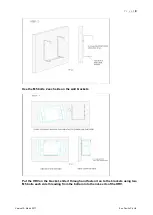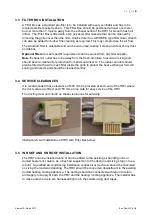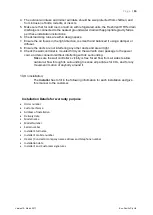
P a g e
|
2
Version10- March 2017
Eco Pacific Pty Ltd
Fresh Filtered Air Heat Recovery Ventilator (HRV)
1. INTRODUCTION
The purpose of this guide is to give the installer and service / maintenance personnel a
quick reference to general information they must know when installing the ECO PACIFIC
HRV.
This publication is designed to help the installer. The guide consists of:
•
Overview of HRV;
•
The dealer /
contractor’s responsibilities;
•
Installation procedures, and
•
Warranty details.
1.1 OVERVIEW OF OUR HRV
This Eco Pacific Heat Recovery Ventilator innovation substantially improves the quality of
indoor air, which is increasingly becoming an issue in densely populated and polluted cities
of India, China, Brazil, Thailand, South Korea, Hong Kong, Malaysia, Vietnam, and many
other fast developing countries.
The HRV extracts the contaminated air inside rooms and introduces outside fresh air to the
rooms at around the same temperature as the air inside the rooms. This enhances the
rooms air quality and reduces the build up of gases such as CO
2
and unpleasant smells, to
a level that promotes Personal Well Being.
The HRV system employs
energy transfer
between outgoing and incoming air,
utilising a
counter flow Heat Exchanger made of anti-rusting marine grade aluminium alloy,
and does
not make use of or replace a traditional air conditioning system.
The heat exchanger transfers the heat (in winter) or the coolness (in summer) of the
expelled indoor air to the incoming fresh air, due to temperature difference. With an energy
recovery effectiveness of up to 85%, the HRV delivers fresh filtered air at near room
temperatures in all seasons irrespective of outdoor temperatures. The HRV operation
assumes that the indoor space is air-conditioned by an existing heating or cooling device,
which usually only recycles the same indoor air within closed doors and windows. There is
no active heating or cooling device fitted in this HRV, but rather a passive Heat Exchanger
that exchanges sensible heat energy between the incoming and outgoing air streams. The
standard HRV operates through a normal 240 V, 10 Amp switch, like a normal ceiling fan.
The incoming outdoor air passes through an externally mounted filter box. The filter box is
connected through a duct to the HRV mounted either on a wall, in a roof cavity, or on the
roof.
Optional:
The HRV can also be operated by an Optional Wall Controller fitted with sensors
for either CO
2
levels of the indoor air, any motions surrounding the wall controller, or
blockage of the outdoor air filter. If the CO
2
of the room reaches harmful levels and the
ventilator is in auto-off mode, the sensor will automatically activate the ventilator to provide
fresh filtered air at near room temperature. If the filter is blocked, the LED on the On-Off
switch or on the Wall Controller will turn Red to indicate that the filter needs to be cleaned.
A house fitted with this HRV will not require open doors or windows, and will introduce fresh
filtered atmospheric air in the living space at near room temperatures, and assist in keeping
the house clean and hygienic, so as to enhance a
Healthy
Well Being effect
in the house.

